牛津译林版(2019)必修第二册Unit 2 Be Sporty, Be Healthy Extended reading 课件(共22张PPT)
文档属性
| 名称 | 牛津译林版(2019)必修第二册Unit 2 Be Sporty, Be Healthy Extended reading 课件(共22张PPT) |  | |
| 格式 | pptx | ||
| 文件大小 | 30.9MB | ||
| 资源类型 | 教案 | ||
| 版本资源 | 牛津译林版(2019) | ||
| 科目 | 英语 | ||
| 更新时间 | 2024-07-24 21:18:46 | ||
图片预览

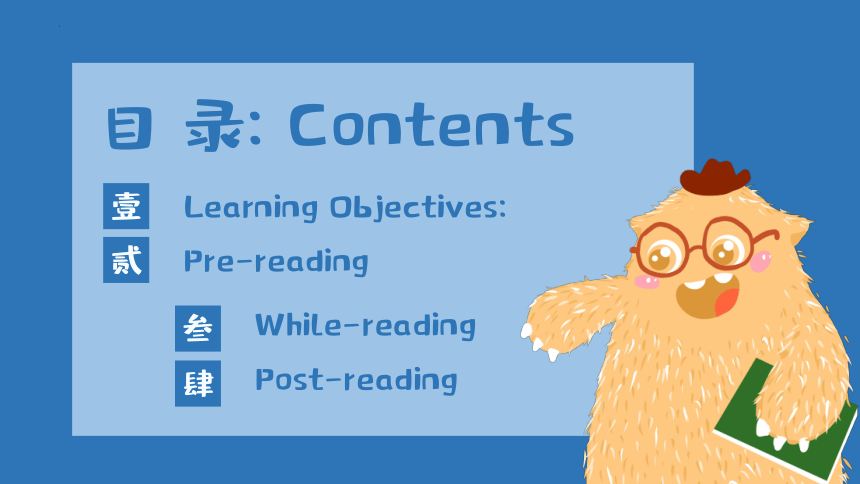

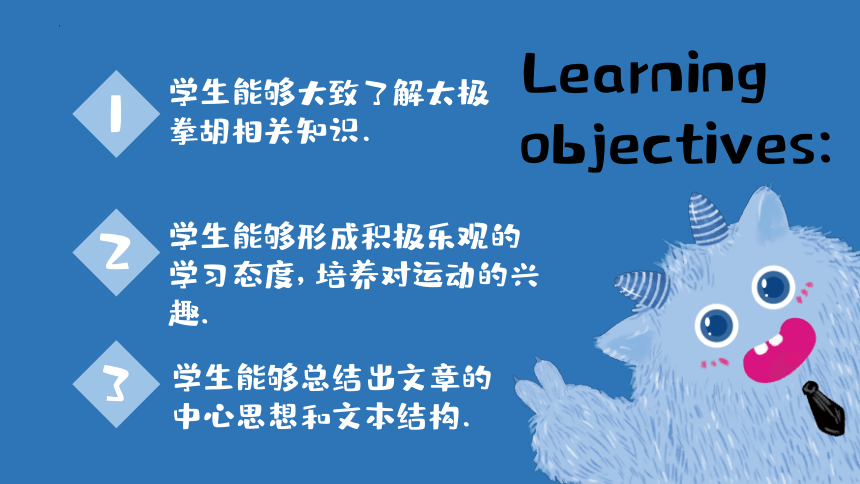
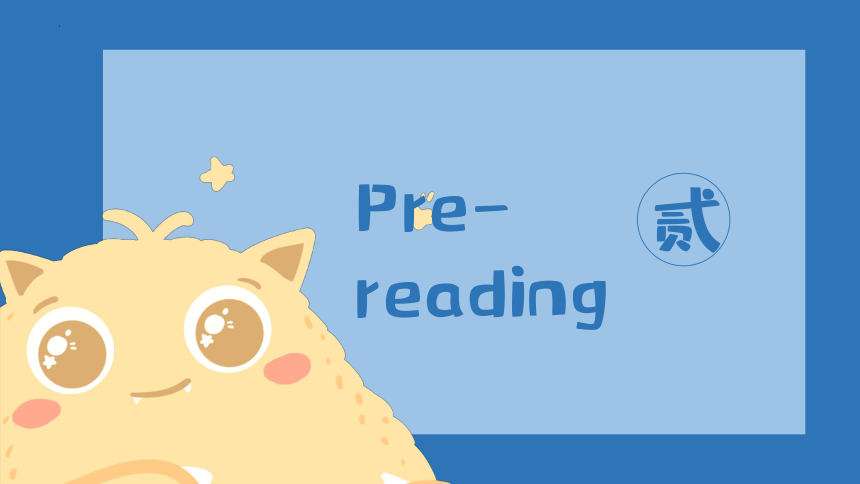
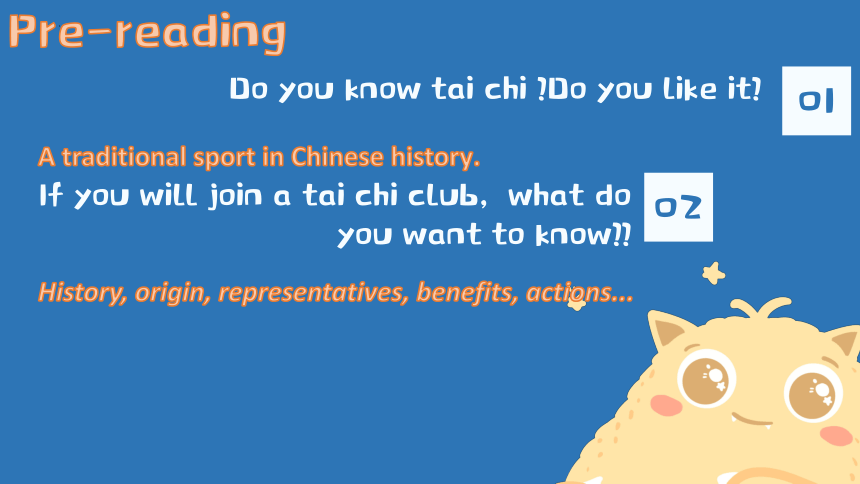
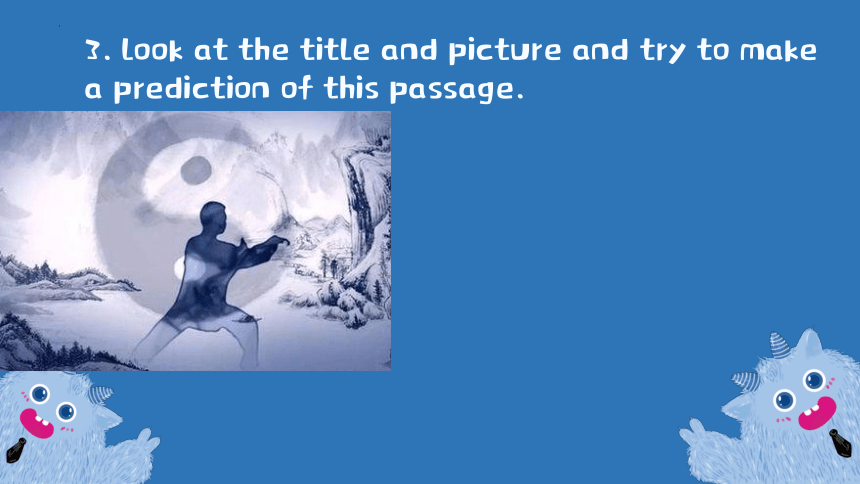
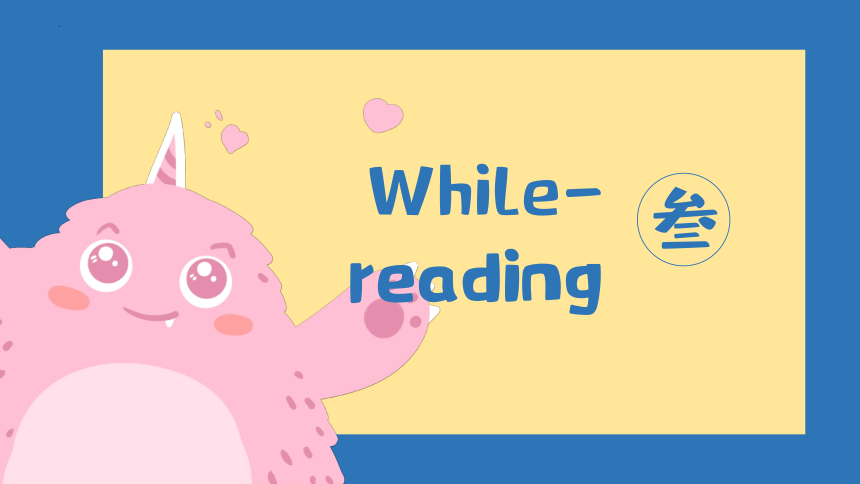

文档简介
(共22张PPT)
Unit 2 Be sporty, be healthy
Extended Reading
目 录:Contents
壹
贰
叁
肆
Learning Objectives:
Pre-reading
While-reading
Post-reading
壹
Learning Objectives
1
2
学生能够大致了解太极拳胡相关知识.
学生能够形成积极乐观的学习态度,培养对运动的兴趣.
Learning objectives:
3
学生能够总结出文章的中心思想和文本结构.
贰
Pre-reading
01
Do you know tai chi Do you like it
02
If you will join a tai chi club, what do you want to know
A traditional sport in Chinese history.
History, origin, representatives, benefits, actions...
Pre-reading
3.look at the title and picture and try to make a prediction of this passage.
叁
While-reading
1.Work in pairs and try to write down the structure of this article
Introduction
History
Moves
Finding a balance:
My tai chi experience
para.1
para.2
para.2-3
Fast reading
Culture behind tai chi
para.4
Effects
para.5
2.Read the para.2 and find out the history of tai chi.
Zhang Sanfeng had invented tai chi from a fight between a snake and a bird.
Chen Wangting had developed tai chi according to the martial arts skills.
Careful reading
3. 课文理解
1). Which one is NOT the information that the author had learned from the coach
A. Ways to relax his muscles.
B. Ways to keep the peace of mind.
C. Some more difficult moves.
D. The philosophy of yin and yang.
Careful reading
D
3. 课文理解
2).Where did these basic moves origin
A. Chinese martial arts have imitated animals for a long time.
B. Zhang Sanfeng invented tai chi from a snake and a bird.
C. These names are easy to remember.
D. Chinese love animals.
Careful reading
A
3. 课文理解
3). What's the main point of this article
A. A brief introduction to tai chi.
B. Tai chi experience.
C. Physical and mental balance.
D. A balance through tai chi experience.
Careful reading
D
肆
Post-reading
一、 课文语法填空(1)
Before 1. _________(join) the tai chi club, the author 2. ____________
(hesitation) and believed tai chi was for old people. But in the first few classes, he found tai chi classes fun and 3. ____________(easily). Moreover, the moves caught his 4. ____________(inspire) and he learned the history of tai chi. 5. ____________, after the first few classes, he found that he was bored and aching from 6. ____________(repeat) the same moves.
joining
hesitated
easy
inspiration
However
repeating
一、 课文语法填空(2)
Luckily, his coach taught him how to relax his muscles and focus on peace of mind, 7. ____________improved his balance and flexibility 8. ____________(slow). In time, he began to look 9. ____________ the ancient Chinese culture behind tai chi. One year later, tai chi had a positive 10. ____________(effective) on his everyday life.
which
slowly
into
effect
2. In pairs and discuss these questions
How do you understand the philosophy of tai chi
Everything always keeps balance and no one could break it. Like days and nights, love and hate....
What is attitude towards tai chi
I love it, because it can help strengthen my bones...
1
2
Language points
Language points
1.hesitate v. 犹豫
hesitationn. 犹豫
hesitate to do ...做...有顾虑
hesitate about... 对...犹豫.
without hesitation 毫不犹豫地
2.admit v.承认,准许进入
admission n. 承认;允许进入;入场费
admit (to) doing... 承认做了...
It is admitted that...人们认为...
be admitted into/to 被录取,被接纳
Language points
3.inspire v. 鼓舞;启发,使产生...
inspired adj.激动人心的
inspiring adj. 鼓舞人心的
inspiration n. 灵感;给以灵感的人
inspire sb.to do ... 鼓励某人做...
be inspired by... 受到...鼓舞
Thank you for your attention!
Unit 2 Be sporty, be healthy
Extended Reading
目 录:Contents
壹
贰
叁
肆
Learning Objectives:
Pre-reading
While-reading
Post-reading
壹
Learning Objectives
1
2
学生能够大致了解太极拳胡相关知识.
学生能够形成积极乐观的学习态度,培养对运动的兴趣.
Learning objectives:
3
学生能够总结出文章的中心思想和文本结构.
贰
Pre-reading
01
Do you know tai chi Do you like it
02
If you will join a tai chi club, what do you want to know
A traditional sport in Chinese history.
History, origin, representatives, benefits, actions...
Pre-reading
3.look at the title and picture and try to make a prediction of this passage.
叁
While-reading
1.Work in pairs and try to write down the structure of this article
Introduction
History
Moves
Finding a balance:
My tai chi experience
para.1
para.2
para.2-3
Fast reading
Culture behind tai chi
para.4
Effects
para.5
2.Read the para.2 and find out the history of tai chi.
Zhang Sanfeng had invented tai chi from a fight between a snake and a bird.
Chen Wangting had developed tai chi according to the martial arts skills.
Careful reading
3. 课文理解
1). Which one is NOT the information that the author had learned from the coach
A. Ways to relax his muscles.
B. Ways to keep the peace of mind.
C. Some more difficult moves.
D. The philosophy of yin and yang.
Careful reading
D
3. 课文理解
2).Where did these basic moves origin
A. Chinese martial arts have imitated animals for a long time.
B. Zhang Sanfeng invented tai chi from a snake and a bird.
C. These names are easy to remember.
D. Chinese love animals.
Careful reading
A
3. 课文理解
3). What's the main point of this article
A. A brief introduction to tai chi.
B. Tai chi experience.
C. Physical and mental balance.
D. A balance through tai chi experience.
Careful reading
D
肆
Post-reading
一、 课文语法填空(1)
Before 1. _________(join) the tai chi club, the author 2. ____________
(hesitation) and believed tai chi was for old people. But in the first few classes, he found tai chi classes fun and 3. ____________(easily). Moreover, the moves caught his 4. ____________(inspire) and he learned the history of tai chi. 5. ____________, after the first few classes, he found that he was bored and aching from 6. ____________(repeat) the same moves.
joining
hesitated
easy
inspiration
However
repeating
一、 课文语法填空(2)
Luckily, his coach taught him how to relax his muscles and focus on peace of mind, 7. ____________improved his balance and flexibility 8. ____________(slow). In time, he began to look 9. ____________ the ancient Chinese culture behind tai chi. One year later, tai chi had a positive 10. ____________(effective) on his everyday life.
which
slowly
into
effect
2. In pairs and discuss these questions
How do you understand the philosophy of tai chi
Everything always keeps balance and no one could break it. Like days and nights, love and hate....
What is attitude towards tai chi
I love it, because it can help strengthen my bones...
1
2
Language points
Language points
1.hesitate v. 犹豫
hesitationn. 犹豫
hesitate to do ...做...有顾虑
hesitate about... 对...犹豫.
without hesitation 毫不犹豫地
2.admit v.承认,准许进入
admission n. 承认;允许进入;入场费
admit (to) doing... 承认做了...
It is admitted that...人们认为...
be admitted into/to 被录取,被接纳
Language points
3.inspire v. 鼓舞;启发,使产生...
inspired adj.激动人心的
inspiring adj. 鼓舞人心的
inspiration n. 灵感;给以灵感的人
inspire sb.to do ... 鼓励某人做...
be inspired by... 受到...鼓舞
Thank you for your attention!
